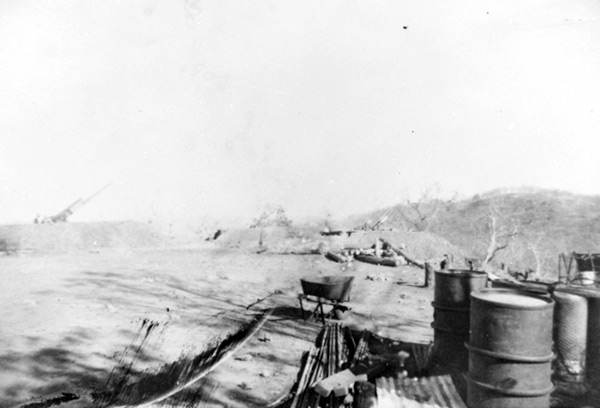|
|
|
|
| Missing In Action (MIA) | Prisoners Of War (POW) | Unexploded Ordnance (UXO) |
| Chronology | Locations | Aircraft | Ships | Submit Info | How You Can Help | Donate |
|
| Australian Army 23rd Heavy Anti-Aircraft Battery  AWM March 19, 1942    AWM July 15, 1942  Dargie Sept 1942  December 29, 1943    Justin Taylan 2007 |
Location Tuaguba Hill Gun Battery was located atop Tuaguba Hill at Port Moresby. This hill has a commanding view overlooking Port Moresby (Town) and Paga Hill to the west and Fairfax Harbor to the northwest and Ela Beach and Walter Bay to the south. Also spelled "Tua-guba" or "Touaguba" or "Ack Ack Hill". Prewar The summit of Tuaguba Hill was undeveloped with only a small walking track led to the summit. Construction The Australian Army selected this location for the first heavy anti-aircraft battery to defend Port Moresby. Australian Army engineers and local laborers expanded the track into a road and transported the guns and construction materials to the top of the hill over several weeks during January 1942. Wartime History Atop the summit Tuaguba Hill were emplaced four 3.7" Heavy Anti-Aircraft Guns (H1) built in Maribyrnong, Victoria. A predictor was installed on a concrete base. Also, an enclosing revetment made from empty drums filled with coral rubble. The battery was manned by the Australian Army, 23rd Heavy Anti-Aircraft Battery, one section. The four guns were nicknamed: "Strawberry Blonde", "The Avenger", "Leader of the Opposition" and "Dorothea" (named after one of the gun sergeant's girlfriend). Several Lewis machine gun pits, to protect against low flying aircraft. Later an underground bunker was also constructed at the center of the installation. By the middle of February 1942, only three guns were calibrated before the first major Japanese air raid against Port Moresby. During 1942-1943 this battery was manned full time ready to go into action against attacking aircraft. As the first battery established to defend Port Moresby, the Tuaguba Hill Gun Battery was the only anti-aircraft defense between February 1942 until April 1942 when more batteries went into action. In wartime news reports, the battery claimed 43 enemy aircraft. In reality, the damage inflicted to enemy bombers was far less. Japanese reports often indicate anti-aircraft fire as "severe" during the period this battery was the only one in operation. On March 19, 1942 this battery fired 146 rounds at Japanese G3M2 Nells from the 1st Kokutai (1st Air Group) that released 60 kg bombs that impacted on one side of the hill, and came up over the top between the guns and down the other side without scoring any direct hits on the gun positions. At one point, the battery ran out of ammunition, as it was firing nearly every day at attacking Japanese aircraft. The first set of barrels were worn out from firing, and sent back to Australia for evaluation. Once, a Japanese "500 pound bomb" (likely a 250 kg bomb) hit three meters from a machine gun pit. Amazingly, the crew were unhurt but shell-shocked and withdrawn from combat. On March 21, 1942 when the first Royal Australian Air Force (RAAF) P-40E Kittyhawks arrived to land at 7-Mile Drome, none of the gun batteries were alerted about the arrival of friendly fighter aircraft. Machine gunners on the hill fired on them mistaking them for Zeros. Tuaguba Hill Gun Battery was manned into late 1943, when the threat of air raids had sufficiently passed and other anti-aircraft defenses helped defend the Port Moresby area. Late in the war or immediately postwar, the guns were removed. Today The summit of this hill was largely untouched since the Pacific War. Atop the hill are concrete pads, barrels filled with rubble to create revetments and depressions indicating the location of machine gun pits. The concrete bunker at the center of the battery also remains. During 2006, a mobile phone tower was built at this location. References The 'Letter' Batteries (1998) by Reg Kidd & Ray Neal details the history of this gun battery The Coastal Gun Batteries of Port Moresby - Then & Now by John Douglas Australians at War Film Archive interview with Eric White, 23rd AA Battalion Thanks to John Douglas and Edward Rogers for additional information Contribute
Information Last Updated
|
Map 1942 View in Google Earth Photo Archive |
| Discussion Forum | Daily Updates | Reviews | Museums | Interviews & Oral Histories |
|